
Boost Your Cell Phone Service While Driving With This Tool
June 9, 2022
We’ve all experienced that “Can you hear me?” moment due to spotty cell service while on the road. Whether it’s constant dropped calls, crackling reception or poor audio, poor cell service can get in the way of connecting with your family and friends. It can add frustration and stress while driving, which doesn’t help anyone!
So, how can you address poor service and try to improve it? A cell phone booster might do the trick.
How do boosters work to improve cell service?
One of the best ways to get cell service in a low-signal area is with a cell phone signal booster. Boosters can improve a weak cell signal and make it strong enough to work in places where it wouldn’t otherwise be available. They work by strengthening the existing signal to a usable level inside a home or vehicle. As a result, they can carry a weak cell signal to places where there previously was none or almost none.
How do cell signal boosters work?
Boosters work by using a combination of strategically placed antennas to pick up weak signals from the nearest cell tower. Then, the device boosts the signal and directs it where it’s needed. Boosters also allow the cell signals to overcome blocks such as trees or buildings. All you need is access to the roof of the building or vehicle in which the signal boost is required, including dead zones.
Are there other benefits to having a signal booster?
Yes! Cell phone service boosters can give you more reliable data uploads and downloads, so your data transfers will go faster, and your streaming music services, and video players won’t pause to buffer as much. They can also help with faster text messaging and increase your mobile device’s battery life.
What’s the best cell service booster to use while driving?
The type of cell service booster that will work best for you depends on a variety of factors. Some things to consider include:
What type of wireless connection do you need?
Some boosters only transmit 3G broadband internet, some only 4G, and some do both. The difference is the data transfer speeds. However, it’s a good idea to look for a booster that transmits 4G internet, as it can also work with 2G and 3G devices as well.
How many users will there be?
If you have multiple devices simultaneously using the system, look for one that can handle the traffic. Some systems are designed for only one phone at a time, while others handle multiple phone calls simultaneously.
Ultimately, choosing the right booster comes down to your specific situation and research to find what fits your needs. Once you find one that works, it can make it easier to connect while you’re on the road.
Do you have a booster you like to use? Share them with us on Facebook, Instagram, or Twitter!






